How to Construct a Storm Runoff Detention Basin for Flood Prevention



A determination of a proper detention basin size will be for a proposed five acre site in order to prevent flooding from foreseeable environmental concerns from a 25 year storm.
In order to determine the detention basin size, the amount of runoff (water) from the site must be determined. Environmental factors must be considered, such as the intensity of rainfall on the site, the type of surface the runoff is moving on, and the size of the area. Furthermore, the flow in and flow out of the detention basin is important in determining size proportions.
Diagram
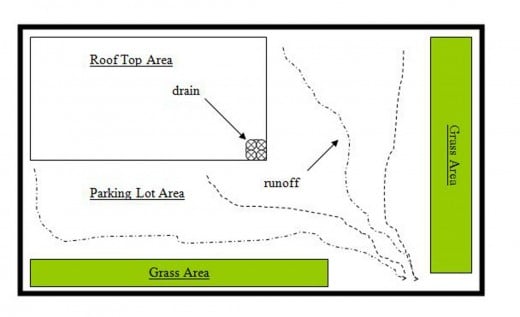
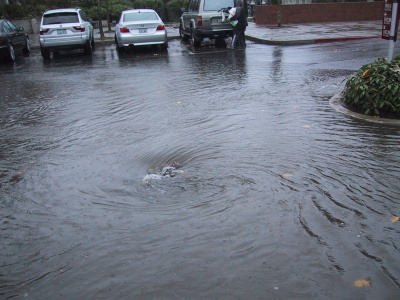
Diagram Area Information
- Roof Top Area = 1 acre
- Parking Lot Area = 3.5 acres
- Grass Area = 0.5 acres
- Total Area = 5 acres
- Runoff velocity for rooftop and parking lot = 1ft./s
- Length of parking lot = 500 ft.
- Width of parking lot = 430 ft
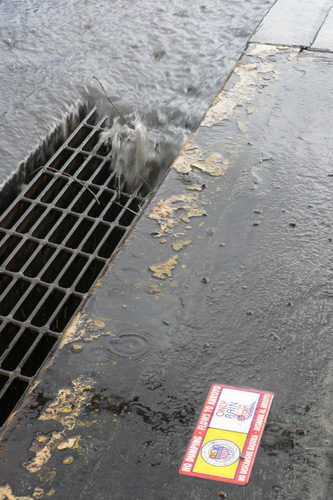
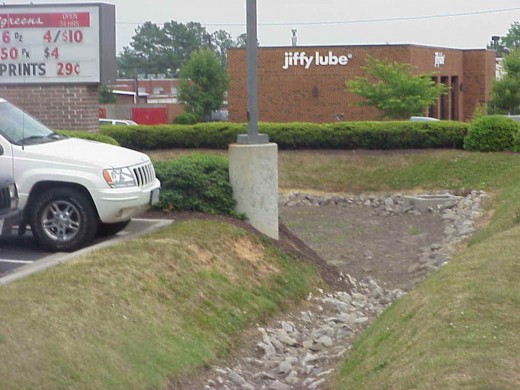

Data
The peak flow of the area is determined by the formula:
Q = CiA
- Q = peak flow
- C = runoff coefficient determined by surface type
- i = the 25 year rainfall intensity maximum, which is the time for the drainage area to the flow in inches/hour
- A = the drainage area (acres)
The runoff coefficient is determined by the type of surface the runoff is moving on. The roof and parking areas have a coefficient of 0.9 determined from a surface coefficient chart. The grass area is assumed to retain most of the runoff.
The rainfall intensity is determined by calculating the time the runoff takes to move to the outfall and then using it to determine the intensity from an intensity-duration curve. The 25 year average frequency intensity figures came from the intensity-duration curve from Water and Wastewater Technology, Fifth Edition.
The drainage areas are the roof, parking lot, and grass area. Since the grass area is assumed to retain some of the runoff that passes over it, it will be subtracted from the drainage area.


Rainfall Intensity (i)
A2 + B2 = C2
5002 + 4302 = C2 (500ft. and 430ft. are the length and width of site)
434,900 = C2
659 ft. = distance to outfall
D = vt
659ft. = (1ft./s)t
t = 659s * 1min/60s = 11 min.
11 minutes = 6.0 in/hr from rainfall intensity-duration curve

Drainage Area
Drainage area = total area – grass area
= 5.0 acres – 0.5 acres
= 4.5 acres


Peak Flow
Q = CiA
= (0.9) (6.0 in. /hr) (4.5 acres)
= 24.3 acre in./hr
= 24.3 ft.3/second (refer to graph below)
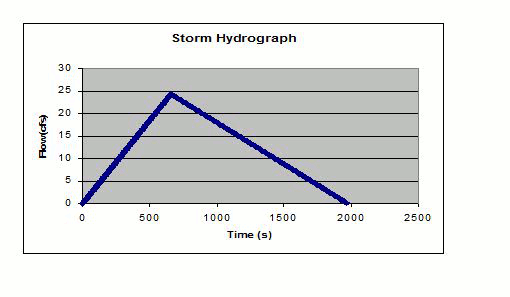
Discharge from Basin
The exit hole or discharge orifice of the retention basin is 0.09 ft 2, which is a standard discharge size.
The flow out of the basin can be calculated with this formula:
QExit = (exit area) (discharge coefficient) √ (2gh)
Exit area = 0.09ft 2
Discharge coefficient = 0.9
g = gravitational constant = 32.3 ft./s 2
h = maximum height of water in the basin = 14.0 ft. (refer to detention basin diagram below)
QExit = (0.09 ft2) (0.9) √ (2*32.3ft/s2*14.0ft)
= 2.44 ft3/s = 10% of peak flow (refer to graph below)
The flow out of the discharge basin is important because the outflow should not overwhelm the water source it is running into, which could have a negative impact on its environment. The QExit is 10% of the peak flow.
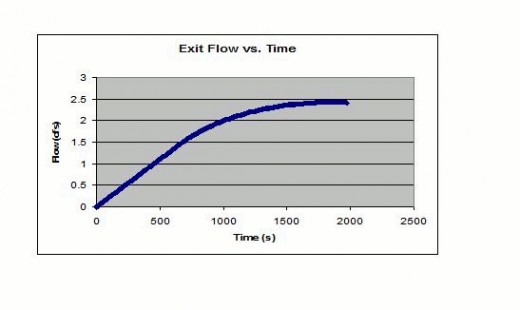
Detention Basin Diagram
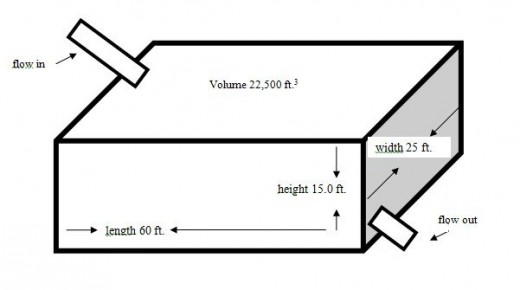
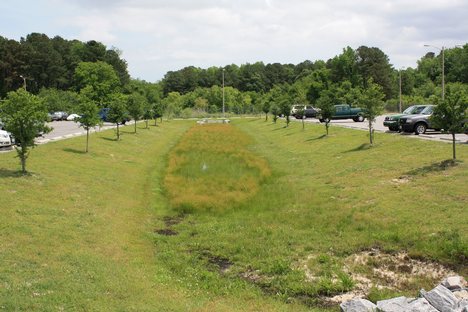
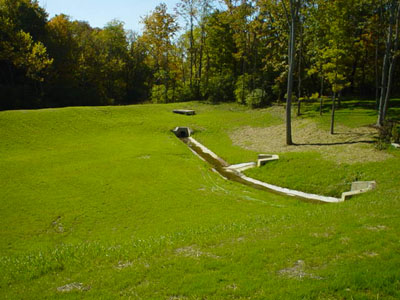
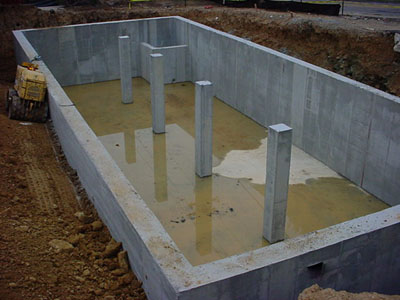
Size of Detention Basin
If the basin area is given to 1500ft2, and the height of the runoff is at 14.0 ft. at its maximum height, then the maximum volume can be calculated.
Volume of Runoff
V = Volume
A = area = 1500 ft.2
H = height = 14.0 ft.
V = A*H
= (1500 ft. 2) (14.0 ft.)
= 21,000 ft.3 volume
Since the maximum volume of runoff is determined, then the detention basin must increase in height to retain the 21,000 ft.3 volume. The dimensions can be determined by using the formula (V = A*H ) again, but changing the height to a larger size of 15.0 ft.
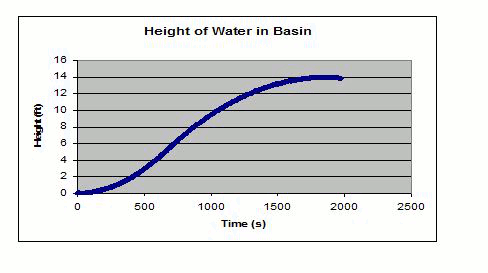

Detention Basin Size Calculation
V = A*H
= (1500 ft.) (15.0ft.)
= 22,500 ft.3
The height of the basin was rounded off to 15.0 ft. to give 22,500 ft.3. The area (A) which is 1500 ft., can be split into length and width for the basin, because area = length * width.
Calculation for Length, Width, and Height of Detention Basin
V = L * W * H
= (60.0 ft.) (25 ft.) (15.0 ft.)
= 22,500 ft.3
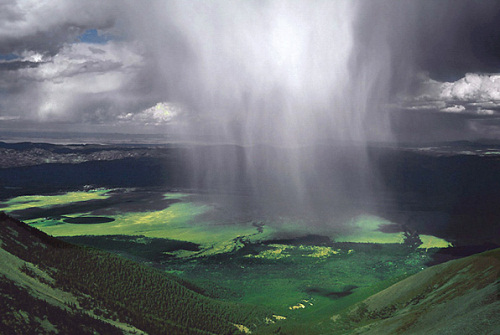

Conclusion
The detention basin size for the 5-acre site has been factored for a 25 year storm. The different variables of the site have been covered such as peak flow, rainfall intensity, size of the area, and the discharge and size of the retention basin. From this, the dimensions of the basin should contribute to a proper size basin for the site.
Have you experienced a 25 year storm?
Related Articles
- The Walkerton Incident
The big question was, why did the Public Utility knowingly mislead the town of Walkerton into believing that the quality of their drinking water was safe when in fact it was contaminated with potentially deadly strain of pathogens?
© 2011 PlanksandNails



